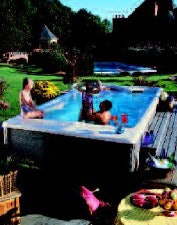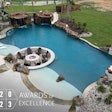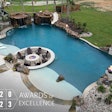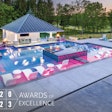
Once most people learn about everything a swim spa has to offer, they want one. That's unless they already have a pool and spa in their backyard. For those who don't, especially the millions of aging Baby Boomers, a swim spa could be the perfect fit. They can easily be used year-round, they take up much less space, and are more efficient to heat and operate than a 20-by-40-foot pool and adjoining spa. And while they're not inexpensive, they're no more costly than a basic pool and spa, and a swim spa can be installed in one day.
Perhaps the biggest benefit to consumers is the many ways a swim spa can be used. As the name suggests, people often swim in the spas, but they can also be a space for other aquatic exercise, family fun and therapy. And the more uses your clients can visualize for the swim spa they're thinking of buying, the more sales you'll close.
Choices
Recognizing that customers would like a swim spa with a variety of exercise options, Dimension One Spas designed its Aquatic Fitness Systems with not only jets to provide a current, but also equipment to facilitate an upper-body rowing workout and an underwater treadmill. "So you could swim for a while, you can jog, you can do aerobics and you can weight train in it," says Dimension One CEO Bob Hallam. "The concept here is you've got a choice.
"We brought this out for the Baby Boomers," adds Hallam. Since many Baby Boomers suffer from aches and pains that make exercising on land either painful or out of the question, exercising in water is a great alternative because it's easier on joints.
Plus, muscles get a better workout in the water because Illuminate the many uses of a swim spa and watch sales light up it provides seven times more resistance than air, says Rebecca "Boo" Pfeiffer, a Miami-based certified personal trainer.
"So if you're running in water, you're actually getting more resistance and more work on your muscles than you would running on land, and you have less stress on your joints."
This is evidenced in feedback Dimension One has received. "The first person we sold an Aquatic Fitness System to lost about 25 pounds in the first year just because they had a device they enjoyed and it wasn't killing them," says Hallam. "They didn't get up every morning thinking about how their knee or back or hips hurt, which is something a lot of people have problems with."
Dimension One has heard from other Aquatic Fitness System owners, as well. In fact, representatives from Dimension One even visit clients in their homes and observe them as they use their spas. "We spend a lot of time watching customers use their spa because when you talk to a customer about their spa, you'll get some basic feedback," says Hallam. "But we send people to sit there and watch people use their hot tubs. We want to see how they get in, how they get out, which seat they use, how they use it, is it comfortable. And if you ask them questions as they use it, you get much more specific feedback."
For instance, Dimension One learned from this research that customers would prefer easier access to the filter on the Aquatic Fitness System. "We had a lot of complaints: I don't want to go underneath and change the filter. I want to make this as easy as possible," says Hallam. "So that's where we got the idea of putting the filters on top."
Relief And Rigor
In developing its new swim spa, the H2X, Master Spas also incorporated quite a bit of research. "We spent a year in planning and development," says Bob Lauter, president of Master Spas. "We had a test tank where we tested the propulsion system in it to see what length we needed so there were no hidden obstructions like benches or steps, so that a person could swim, even a tall person, without worrying about whacking their toes on something.
"And we tried to figure out how we could construct the spa so that we would keep the current all going one direction, rather than having it come up the side walls.
"We also talked to certified trainers and to the 'Poolates' people about what we would need in the swim spa as far as space for them to do exercises and what bars we might need to hook up the apparatus to." (Poolates is a new exercise form explained in greater detail below).
In the end, Master Spas incorporated a large swim area, the patented Exerswim propulsion system, grab swim rails to facilitate various exercises, and a jetted seat and cove for therapy into the design of the H2X.
"The propeller system is a lot more efficient at creating a current," says Lauter, "and it gives a much broader, deeper current that makes it a lot easier to swim against because you've got current underneath you that's lifting as well. So it's a lot easier to find a sweet spot and stay in it because the sweet spot is a lot bigger. With jets creating a current, you've got this powerful blast of water mixed with air that is a narrow current, and it's tough to swim against."
The therapy seat and cove were included, says Lauter, because "we've tried to come up with a way to provide therapy for every part of the body for someone that just wants to have some pain relief." The therapy seat, which looks much like a traditional hot tub seat, has an X-pattern of jets to provide relief to the back, hips, thighs, calves, arms, wrists and hands. The therapy cove has a grab rail and jets are positioned to offer relief to the lower back, hips, legs and knees. "It's the kind of place you can get therapy that would be tough to get any other way, particularly on the front part of your body," says Lauter.
Beyond Swimming
Most people can figure out that standing next to or sitting by jets provides tremendous relief, but aquatic exercise, aside from swimming, is not always as intuitive. Because Master Spas wanted to offer its clients some direction, the company has teamed up with Pfeiffer, creator of the Poolates program, which she says "blends the principals of Pilates — including control, concentration, centering, breathing, precision, awareness and flow — with the benefits of aquatic exercise."
Says Lauter, "We wanted to partner up with her because we felt we needed to offer a specific program that could be done in our swim spa for people at all different levels of fitness for strengthening their lower backs and their stomachs and gaining flexibility."
Pfeiffer, who was already a huge fan of aquatic exercise before trying out the H2X, believes the swim spa is ideal because it's "one-stop shopping."
"Say for example you have lowerback problems," says Pfeiffer, "and you need to soak in warm water to loosen up your back. The H2X has that wonderful seat with all those jets, so you can sit in the jet seat in the warm water, just relax there for a few minutes, and let the water do its great work loosening you up. Then you can stand up, turn off the jets and do some stomach and back exercises in the water, go for a walk or run in the water, and then do some cardio that's not going to have you pounding on that back. Then when you're done, you can stretch and sit again in the jetted seat.
"The other really nice thing about having the swim spa current," continues Pfeiffer, "is when you do something like Poolates or weight training where you're using the resistance of the water, you can make the water more resistant by doing the weight training against the jets. So if you submerge one of the big aqua dumbbells, and say it normally has the resistance of 8 pounds on land, and then you try to control it against the jet, I can tell you it feels a lot heavier than 8 pounds and you're working a lot harder to control it."
Pfeiffer stresses that aquatic exercise is not just for those who find it difficult to work out on land. "For the world-class athlete, there's still a tremendous challenge," she says. "It might be that running in a regular pool isn't so challenging for the worldclass athlete, but have him run against the swim spa jet and all of a sudden he's getting a great training session."
Poolates, which improves posture, strength, balance and flexibility through a series of exercises, is also for people at all different fitness levels, says Pfeiffer. Howard Cohen, a former competitive swimmer and now a writer for The Miami Herald, tried Poolates and had this to say: "After an hour of walking across the floor of the pool while lifting the knees above the waist, leg circles, pushing a pull-buoy under water with the back of a leg and doing double knee lifts on the pool steps, I felt like I had a real workout."
Wider Is Better
Yet another option in the swim spa category is the Aquatrainer from Hydropool, which, says company president David Jackson, can be installed indoors, in the ground, in a deck or above the ground, like a hot tub. "We have lots of flexibility," he says.
The Aquatrainer's current is generated with jets, but Jackson explains how it's still a smooth current: "Most swim spas use a round nozzle, which gives a fairly direct pressure and is a little more turbulent and a little more difficult to stay in the current. What we have is a wide-stream jet, so instead of a round, 2-inch nozzle, our jet is just over 1 by 6 inches, and what it delivers is a much more level, even and wider current. This wider current is easier to stay in, and it's less turbulent and less direct. In addition, it's designed so the stream curls in the hydrotherapy seats, so that there's not a lot of backwash and you get a very smooth, comfortable swim."
The Aquatrainer also has a variedflow current. "You can control the jets so there's between 450 and 700 gpm coming out of the jets," says Jackson, "And the homeowner can do that themselves using valves and make either a much stronger swim or a much lighter swim."
The Hydropool swim spa, like other suppliers' models, can also serve as a soaking pool or a place for kids and families to play, "just like a pool, but smaller," says Jackson. And as lots get smaller and smaller across the country, the versatility of swim spas should not be overlooked. Lauter sums up the capabilities of the units well: "A swim spa should really be called the swim, aquatic exercise, family fun, rehabilitation spa, because it can do all those things."
Eliminating Barriers
It's well known that Baby Boomers are the target market for makers and sellers of hot tubs and swim spas. But another group that can reap the benefits of these therapeutic vessels are children with disabilities. "There are a lot of parents who choose to put in some sort of spa for their kids with disabilities because of two reasons," says Andrea Salzman, a physical therapist and owner of the Aquatic Resources Network in Plymouth, Minn. "One, often the total number of therapy visits runs out early in the year if you've got a disabled child, so it might be June or July and you don't have any more visits [per insurance] for the rest of the year. So they'll show them things to do and then they'll do them in their own home.
"And the buoyancy makes it easier for an adult to handle a child, as they get to be 11, 12, 13 years old and they can't stand or walk. It's just a free environment for parents with children with disabilities to work with their own child."
Salzman notes other benefits of aquatic therapy: "What they've found is that people who can't stand on land can often stand in pools. And people who don't speak and socialize on land get very vocal when you put them in an aquatic environment. In fact, a lot of speech therapists are starting to use the pool."
Rebecca Pfeiffer, a certified personal trainer based in Miami, has witnessed similar scenarios with adults. Her older clients are often afraid to do balance exercises on land, fearing they'll fall, but they're comfortable doing them in the water. "I find that once they have that fear factor eliminated, it's so easy to do the balance training."
— K.E.







































